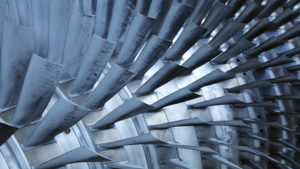

A very common application of heat exchangers is for cooling of hydraulic and lubricating plants, for instance on machine tools that employ hydraulic drives and equipments for their moving parts. But this is also the case of steel mills, where there are many machinery and systems requiring cooling tasks, such as in continuous casting, lamination, forging, a series of processes that need hydraulic units and lubricating systems.
In all of the overall cases, the oil employed for hydraulic drives or simply aimed to lubrication absorbs the heat generated by pumps and/or by the mechanical movement involved. The heat gathered by the hydraulic oil must be dissipated in order to maintain the proper lubricating characteristics and the right viscosity of the oil itself. A decay of its properties would lead to an insufficient lubrication with serious damages to the plants.
All the plants of this kind are then equipped with a cooling system of the oil served by heat exchangers. Oil must usually be maintained at a temperature of 45-50° C, hence the cooling is achieved where it’s possible using air-oil exchangers, otherwise using water-oil exchangers. Based on the size and the capacity of the plant, they can be inspectable type exchangers or brazed heat exchangers.
The thermal duty to be dissipated is related to the installed power capacity of pumps and accessories, in a percentage share directly related to the performance efficiency of the machines (employed to evaluate the part of energy used to power pumps and drives which is transferred to the oil in form of heat).
In case of water cooling, the final user has a series of options for the feeding of the cooling system:
Let’s analyze the three possibilities:
The third option, even if it’s the less eco-friendly, it’s still nowadays the most employed in several small businesses that don’t have other kinds of cooling systems available. Even in this kind of applications, anyway, plate heat exchangers allow to limit the waste of mains water, compared to traditional solutions (shell and tube exchangers, coil exchangers and so on). This is possible thanks to their high thermal transfer efficiency, allowing to achieve very high crossing temperatures.
Talking about water cooling, a mechanical breaking of a tube or a plate is also possible, leading to the mixing of water and oil. If water enters the oil circuit, damages caused to the machinery can indeed be very serious, if not even unfixable. In order to avoid this kind of problems, a very simple solution can be employed: just keeping the oil pressure of the oil circulating within the hydraulic circuit at a higher value of the pressure of the water within the cooling circuit. With this simple trick, even in case of a breakage there will be just an overfilling of the oil into the water, which will be signaled by a decrease in the oil level inside the tank, controlled using dedicated level indicators. In this case, a triggered alarm will be generated, enabling to halt the production and avoiding any possible damage.
A more sophisticated system, employed in some specific cases and for applications using sophisticated and costly machinery, is to implement redundant circuits, having a double oil/oil/water circuit. This solutions is less efficient in terms of energy, but it is the most secure aiming to possible damages prevention.

Among the several applications we have realized in Tempco within this sector, let’s take a clear example of a cooling system designed for a customer specialized in the precision mechanic field, a manufacturer of high precision metalworking machinery with high repeatability.
Modern machine tools for precision metalworking using cutting tools and chip removal employ hydraulic drives for robotic automation. These also need lubro-refrigeration of tools using dedicated cutting oils, for two main reasons:
Both these systems generate heat, that must be dissipated in order to ensure a constant precision level of the metalworking operations. In the specific case, in Tempco we have realized a high efficiency integrated cooling system, involving the use of a series of equipments aimed to guarantee the correct temperature level, both of the hydraulic oil and the cutting oil. The systems employes a centralized refrigerating group, air condensed, hence with a completely closed circuit, without water consumption. The refrigerating group is equipped with a storage tank for the refrigerated water, serving as a buffer tank because metalworking procedures can also be cyclical.
The chiller serves an array of exchangers:
The first position required a previous precise analysis of the performances of the units, in order to achieve a correct evaluation of the thermal duty for the dissipation task. This allowed to correctly determine the consume of water and the working temperature levels, aiming to minimize the power consumption of the refrigerating group.
The second position has been engineered based on the estimation of the amount of heat caused by chip generation and the metalworking operations of the tools.
These were then both analyzed considering the downtimes, optimizing the buffer tank capacity. Therefore it has been possible to further reduce the power consumption of the chiller.
As further improvement, we also implemented a free cooling system, that allows to stop the chiller compressors during the cold season using simple T FIN dissipators, further decreasing the energy costs.